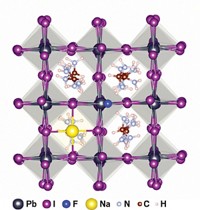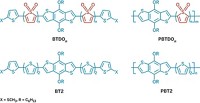Advertisement
Grab your lab coat. Let's get started
Welcome!
Welcome!
Create an account below to get 6 C&EN articles per month, receive newsletters and more - all free.
It seems this is your first time logging in online. Please enter the following information to continue.
As an ACS member you automatically get access to this site. All we need is few more details to create your reading experience.
Not you? Sign in with a different account.
Not you? Sign in with a different account.
ERROR 1
ERROR 1
ERROR 2
ERROR 2
ERROR 2
ERROR 2
ERROR 2
Password and Confirm password must match.
If you have an ACS member number, please enter it here so we can link this account to your membership. (optional)
ERROR 2
ACS values your privacy. By submitting your information, you are gaining access to C&EN and subscribing to our weekly newsletter. We use the information you provide to make your reading experience better, and we will never sell your data to third party members.
Energy
A Solid Solar-Cell Solution
New solid electrolyte bypasses corrosion and durability problems of traditional dye-sensitized solar cells
by Mitch Jacoby
June 11, 2012
| A version of this story appeared in
Volume 90, Issue 24

By replacing the liquid component of a class of thin-film solar cells with a solid, researchers at Northwestern University have come up with a design that avoids the corrosion and durability problems associated with traditional versions of that type of device. The study, reported in a paper in Nature (DOI: 10.1038/nature11067), may lead to new types of inexpensive, long-lasting, and high-performing solar cells composed entirely of solid-state components.
Photovoltaic (or solar cell) technology holds enormous promise for tapping the essentially inexhaustible and non-carbon-emitting energy supply that flows from the sun. Some three-quarters of electricity-producing rooftop photovoltaic panels and other types of solar arrays are based on crystalline silicon cells, a well-established but expensive technology.
Dye-sensitized solar cells (DSSCs) are one low-cost alternative to crystalline semiconductor photovoltaics. The heart of DSSCs consists of a film of inexpensive porous titanium dioxide nanoparticles coated with a sunlight-absorbing dye, often a ruthenium compound, in contact with a liquid electrolyte solution.
As dye molecules absorb light and become energetically excited, they inject electrons into the TiO2 particles, which shuttle the electrons toward one of the cell’s electrodes. The molecules return to their original state via electron transfer from a redox material, the most common of which is an organic electrolyte solution of the iodide/triiodide (I–/I3–) redox couple, which conducts positive charges, or “holes.”
DSSCs are made from inexpensive components and can be fabricated via low-cost manufacturing processes. But the electrolyte solution is corrosive, volatile, and prone to leaking. And it can react with the dye and other cell components. These factors limit the long-term stability and durability of DSSCs.
Researchers have shown previously that the liquid electrolyte can be replaced with a noncorrosive solid-state counterpart. Until now, however, the efficiency of such cells in converting light to electricity has remained low.
The Northwestern group, which includes chemistry professor Mercouri G. Kanatzidis and In Chung, a postdoctoral researcher, has come up with a replacement material that sidesteps those problems. Specifically, the group has shown that substituting the liquid electrolyte with a novel semiconducting inorganic solid—fluorine-doped cesium tin iodide (CsSnI2.95F0.05)—avoids the corrosion and reactivity problems and leads to cells with conversion efficiencies of around 10%. That value is comparable to the efficiencies obtained with newly fabricated traditional DSSCs. They also found that the new cells stand up well to high temperatures, high levels of humidity, and accelerated aging tests.

Kanatzidis relates that he recently learned of the DSSC electrolyte problems—and the requirements for a replacement material—from a presentation by Northwestern’s Robert P. H. Chang, a materials science professor. Among other requirements, the material needs to be a good hole conductor, and it must be solution processable so that it can be mixed intimately with the TiO2 and perfuse throughout the cell.
“I realized that we already had a material with those properties sitting in our lab,” Kanatzidis says. His group had been experimenting with CsSnI3-based compounds as waveguides for other types of solar cells. The group knew that the solid was soluble in acetonitrile, N,N-dimethylformamide, and other polar solvents. It wasn’t long before the Kanatzidis and Chang groups, which also include Byunghong Lee and Jiaqing He, teamed up to make the new types of solar cells.
Kanatzidis points out that unlike conventional solar-cell electrolytes, CsSnI3 absorbs light strongly and causes the new cells to absorb more of the red portion of the visible spectrum than that captured by traditional DSSCs. That property, which may play an important role in the new cell’s high performance, is not yet understood and is the focus of follow-up studies, he says.
The performance of the new cells is encouraging, says chemistry professor Thomas E. Mallouk of Pennsylvania State University. Mallouk, who wrote a commentary for the same issue of Nature, adds that not only does the cell have low internal electrical resistance, which is to be expected for cells that have good hole conductors, but it also achieves high current and voltage.
A range of solid solutions can be made from compounds in this family, which “suggests that elaborating the chemistry of this class of hole conductors may be a fruitful avenue for dye-cell research,” Mallouk adds.





Join the conversation
Contact the reporter
Submit a Letter to the Editor for publication
Engage with us on Twitter